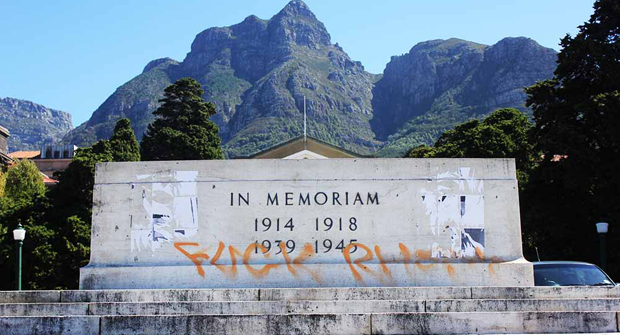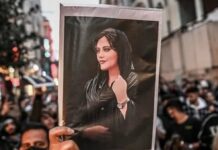A war on statues celebrating South Africa’s racist past is brewing. In the three weeks after UCT student Chumani Maxwele threw faeces at the University of Cape Town’s statue of colonialist Cecil John Rhodes, several statues associated with apartheid and colonialism around the country have been vandalised. RA’EESA PATHER rounds up the statues being targeted.
1. UCT War Memorial gets sworn into vandalism
That tricksy moment when you condemn a fascist by defacing a memorial to people killed while fighting fascism. pic.twitter.com/1uoE6Wt2Ps
— Tom Eaton (@TomEatonSA) April 6, 2015
Last week UCT’s war memorial was vandalised with graffiti that said “Fuck Rhodesâ€. The memorial, which sits above the Rhodes statue on upper campus, commemorates members of the university community who died in the two world wars. Columnist Tom Eaton posted an image of the defaced monument on Twitter and Facebook, pointing out the hypocrisy of vandalising a memorial dedicated to South Africans who died fighting facism. In a blog post titled “Accidents of Historyâ€, Eaton argues against the idea that World War Two was a “white man’s warâ€, detailing the colonialist dream of the Nazis to conquer Namibia, Zambia and Mozambique, while South Africa was to be a “nominally independent state run by pro-Nazi Afrikaners, rewarded for their racial ideologies with stewardship of Lesotho, Swaziland, Botswana and Zimbabweâ€.Â
Let’s just tackle the WW2 memorial issue. It’s tricky that one because the thing is, while fighting Hitler, they had colonies so you see — Nomalanga Mkhize (@NomalangaSA) April 6, 2015
But Nomalanga Mhkize, a lecturer in Rhodes University’s history department, argues that the context of colonialism makes the vandalisation of the War Memorial more complex. While Mhkize tweeted that she is not “saying the courageous men who fought Hitler must be disrespectedâ€,  she states that “Whites came back from WW2 and got farms… meanwhile… our poor grandfathers thinking ish would change… got bicyclesâ€, demonstrating that in the aftermath of a war where “Nazism should have sobered up white supremacists everywhereâ€,  inequalities were still perpetuated and apartheid would rise to rule South Africa.
2. Jan Hendrik Hofemyr gets raised by a black woman
Statue of colonial era Jan on church square in cape town gets an intervention… “A black woman raised me.” Ja, own your history.
Posted by Yazeed Kamaldien on Friday, April 3, 2015
The statues at UCT aren’t the only monuments to be defaced in Cape Town. A statue of Jan Hendrik Hofmeyr, an 1880s Cape parliamentarian, was vandalised this week and its pedestal draped in white material, bearing the words “A black woman raised meâ€.
Hofmeyr, a powerful political agent and chum of Cecil John Rhodes affectionately known as “Onze Janâ€, controlled Dutch interests in the Cape Colony. Hofmeyr, who was associated with the political group known as the Afrikaner Bond, endorsed Rhodes’ rise to prime minister of the Cape Colony.
Hofmeyr’s ties to Rhodes, and his statue at Church Square in the Cape Town CBD – where slaves would wait for the masters to return from church – invariably makes him an easy target for statue reformers.
It’s unclear who defaced the statue.
3. Uitenhage War Memorial on fire
Fighters of Uitenhage!!! Taking on Town Hall!!! Down with colonialist statues down!!! #Siyagijima #Fearfokol ! pic.twitter.com/pTk6NHtIkw
— Outside DSG (@YolzYako) April 2, 2015
The Economic Freedom Fighters (EFF) has embraced the statue wars, calling for the total destruction of monuments to colonialists. Members of the party have been responsible for several defacements in the past few days. In Uitenhage in the Eastern Cape, the EFF necklaced a statue of a South African soldier and set it alight. The monument honours members of the Uitenhage community who fought in the Anglo Boer War between 1899 and 1902.  The EFF claimed responsibility for the vandalism, in which police said 10 members of the party were involved. “We put a tyre around the neck of that white statue and we put it on fire, but after the cops attempted to put out the fire, we took a 10-pound hammer, which we brought ourselves, and attempted to knock it down,†the EFF’s Bo Madwara told Eyewitness News. Police confiscated the hammer, and have since launched an investigation into a case of malicious damage to property.Â
4. Paul Kruger painted greenÂ
EFF vows to destroy the statue of Paul Kruger in Church Square in Tshwane… See video | http://t.co/qXal7WPkdr pic.twitter.com/N5ZHn25I7B — ANN7 (@ANN7tv) April 7, 2015
On Monday, the EFF also claimed responsibility for defacing a statue of Paul Kruger in Pretoria, using green paint.
“The EFF in Tshwane has long launched a campaign where it has demonstrated, calling on the city to remove the statue with immediate effect and substitute it with a different statue or monument,†said EFF national spokesperson Mbuyiseni Ndlozi. He added that the EFF was “very proud of our branches in Tshwane†for taking on a task that is “actually 21 years lateâ€.
Kruger, known both as the “father of the Afrikaner nation†and an “apartheid pioneerâ€, was president of the South African Republic from 1883 to 1900. Kruger strove to protect Afrikaner nationalism and vehemently opposed Rhodes and his British cohort. Kruger’s legacy, like Rhodes’, has been hotly contested in South Africa, and even abroad. In 2009 the Swiss town of St Gallen renamed Krügerstrasse “because of racist associationsâ€.
Afrikaner interestgroup AfriForum has responded to the defacement of Kruger’s statue, with the organisation’s Alana Bailey saying that communities are “becoming dangerously polarised†over the issue.
The Tshwane municipality has posted increased security around the statue and a case of property damage has been opened.
5. The horse memorial and the man who was toppled
Another statue has been destroyed by allegedly EFF members in PE at Russel Road.#sabcEC pic.twitter.com/TbKNy5JOJY
— Zolani Moya (@ZolaniMoya) April 6, 2015
In Nelson Mandela Bay, EFF members struck a bronze statue of a man feeding a horse from its plinth. The monument commemorates the horses that served in the second South African War. While some South Africans on Twitter have lambasted the EFF for attacking a seemingly innocent memorial, the members said it was in line with the party’s mandate. “The toppling of colonial statues is part of EFF’s signal, which indicates rejection of the economic system that has been imposed on us by foreigner settlers,†said Bo Madwara, the EFF chairperson in the region. The EFF claims it will escalate the attack on colonial statues, with plans being made to destroy two statues in Despatch, Eastern Cape, this week, TimesLive reports. Meanwhile back at UCT, the end is nigh for the statue of Rhodes. The UCT Council is set to makes a final decision on the removal of the statue on Wednesday.
UPDATE: Louis Botha painted red
On Thursday morning, Capetonians awoke to find that the Louis Botha statue outside Parliament had been smeared with red paint.
#Statues A Statue of Louis Botha in front of Parliament has been smeared with red and purple paint. RE pic.twitter.com/yvnEAAoY2E
— EWN Reporter (@ewnreporter) April 9, 2015
Which statue will be next? Share your thoughts in the comment section below.









